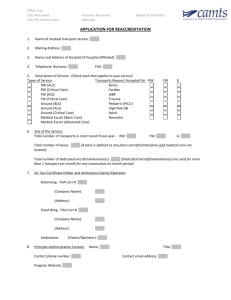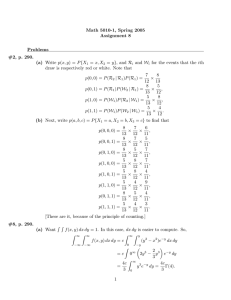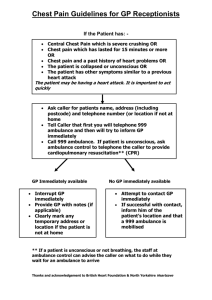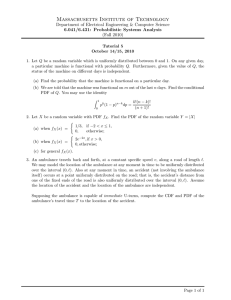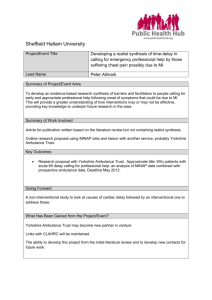NZQA registered unit standard 24869 version 2 Page 1 of 7
advertisement
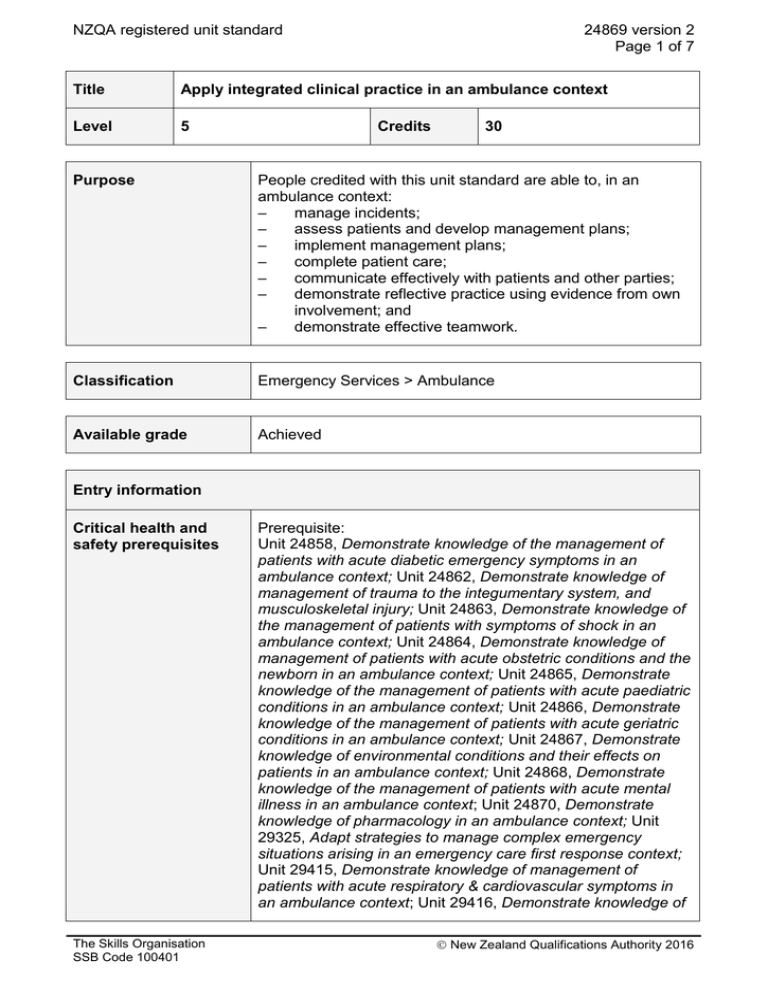
NZQA registered unit standard 24869 version 2 Page 1 of 7 Title Apply integrated clinical practice in an ambulance context Level 5 Credits 30 Purpose People credited with this unit standard are able to, in an ambulance context: – manage incidents; – assess patients and develop management plans; – implement management plans; – complete patient care; – communicate effectively with patients and other parties; – demonstrate reflective practice using evidence from own involvement; and – demonstrate effective teamwork. Classification Emergency Services > Ambulance Available grade Achieved Entry information Critical health and safety prerequisites The Skills Organisation SSB Code 100401 Prerequisite: Unit 24858, Demonstrate knowledge of the management of patients with acute diabetic emergency symptoms in an ambulance context; Unit 24862, Demonstrate knowledge of management of trauma to the integumentary system, and musculoskeletal injury; Unit 24863, Demonstrate knowledge of the management of patients with symptoms of shock in an ambulance context; Unit 24864, Demonstrate knowledge of management of patients with acute obstetric conditions and the newborn in an ambulance context; Unit 24865, Demonstrate knowledge of the management of patients with acute paediatric conditions in an ambulance context; Unit 24866, Demonstrate knowledge of the management of patients with acute geriatric conditions in an ambulance context; Unit 24867, Demonstrate knowledge of environmental conditions and their effects on patients in an ambulance context; Unit 24868, Demonstrate knowledge of the management of patients with acute mental illness in an ambulance context; Unit 24870, Demonstrate knowledge of pharmacology in an ambulance context; Unit 29325, Adapt strategies to manage complex emergency situations arising in an emergency care first response context; Unit 29415, Demonstrate knowledge of management of patients with acute respiratory & cardiovascular symptoms in an ambulance context; Unit 29416, Demonstrate knowledge of New Zealand Qualifications Authority 2016 NZQA registered unit standard 24869 version 2 Page 2 of 7 the management of patients with acute neurological presentations in an ambulance context; Unit 29417, Demonstrate knowledge of the management of patients with acute abdominal symptoms in an ambulance context; and Unit 29418, Demonstrate knowledge of processes to support patient safety and comply with legislation in an ambulance context; or demonstrate equivalent knowledge and skills. Explanatory notes 1 Definitions Ambulance context – situations where emergency care is delivered in a variety of out-of-hospital environments. Out-of-hospital environments refer to any situation in which people require medical assistance outside of a controlled medical environment, such as a medical centre. These out-of-hospital environments include situations both in and away from an ambulance vehicle. For the purposes of this unit standard, the ambulance context also enfolds the interaction of handover or referral to another healthcare provider. Best practice – for the purposes of this standard, a clinical technique or methodology that has proven to be most effective at delivering a desired outcome and is actively promoted across the ambulance and/or emergency care sector. Clinical procedures and guidelines – the written procedures particular to each ambulance service and endorsed by Ambulance New Zealand. Common conditions – include but are not limited to those commonly encountered in an ambulance context. Differential diagnosis – the process of weighing the probability of one condition versus that of other conditions possibly being experienced by a patient. Emergency service personnel – such as Police, Fire, and/or Civil Defence services. Incident – includes but not limited to events that ambulance attend, respond to, or find, that require intervention from the personnel attending. METHANE report – a structured situation report used in the management of major incidents and its description and use is mandated in the Ambulance National Major Incident Plan (AMPLANZ). Reflective practice – an honest and systematic self-analysis of the candidate’s performance during an incident, either in the workplace or in simulation. Standing orders – written instructions issued by a medical practitioner that authorise individuals engaged in the delivery of health services to supply and administer certain medicines without a prescription in circumstances specified in the instruction. 2 References Children, Young Persons, and their Families Act 1989; Children, Young Persons, and Their Families (Vulnerable Children) Amendment Act 2014; Crimes Act 1961; Hazardous Substances and New Organisms Act 1996; Health (Retention of Health Information) Regulations 1996; Health and Disability Commissioner Act 1994; Health and Disability Commissioner (Code of Health and Disability Services Consumers’ Rights) Regulations 1996; Health Information Privacy Code 1994; Health Practitioners Competence Assurance Act 2003; The Skills Organisation SSB Code 100401 New Zealand Qualifications Authority 2016 NZQA registered unit standard 24869 version 2 Page 3 of 7 Health and Safety at Work Act 2015 and relevant related regulations; Health and Safety in Employment Act 1992; Health and Safety in Employment Regulations 1995; Human Rights Act 1993; Medicines Act 1981; Medicines Regulations 1984; Mental Health (Compulsory Assessment and Treatment) Act 1992; Misuse of Drugs Act 1975; Misuse of Drugs Regulations 1977; Official Information Act 1982; Privacy Act 1993; Te Tiriti o Waitangi /Treaty of Waitangi; and all subsequent amendments and replacements. 3 Range Performance in relation to the outcomes in this unit standard is to comply with current clinical procedures and guidelines and/or standing orders and/or current best practice and be appropriate for the patient’s condition. Evidence used for assessment against this unit standard must meet the following requirements: a experiences – minimum of 12 patient contacts with a range of presentations b evidence – at least three different types of evidence from the following: interviews, simulations, objective structured clinical examination (OSCE), observed on-road time, discussions, reflective logs, case studies. Outcomes and evidence requirements Outcome 1 Manage incidents in an ambulance context. Range ambulance vehicle and/or non-ambulance vehicle events. Evidence criteria 1.1 Identify hazards and manage risks at incidents to reduce danger to self, patients, or other people present. 1.2 Assess information about the incidents and plan and implement approaches. Range may include but is not limited to – parking of vehicle, type of incident, number of patients, triage, additional assistance required, changing dynamics of incident scenes, egress. 1.3 Establish and maintain communication with other emergency service personnel at incidents. 1.4 Compile and communicate a METHANE report in accordance with AMPLANZ requirements. The Skills Organisation SSB Code 100401 New Zealand Qualifications Authority 2016 NZQA registered unit standard 24869 version 2 Page 4 of 7 Outcome 2 Assess patients and develop management plans in an ambulance context. Evidence criteria 2.1 Assess patients appropriately to form differential diagnoses and to formulate clinical impressions in a culturally safe manner. 2.2 Describe options for managing patients. Range includes but is not limited to – treatment, transport, positioning, assistance, alternative care pathways. 2.3 Describe risks and benefits of the management options. 2.4 Develop management plans appropriate to patients’ conditions in a culturally safe manner and according to current clinical procedures and guidelines. Outcome 3 Implement management plans in an ambulance context. Evidence requirements 3.1 Initiate the appropriate management plans for the patients in a culturally safe manner. Range includes but is not limited to – general management, specific therapy to treat the patient’s condition. 3.2 Monitor the effectiveness of the management plan continually and identify and describe any changes in the condition of the patients. 3.3 Implement changes to management plans as required. Outcome 4 Complete patient care in an ambulance context. Evidence requirements 4.1 Complete patient handover and communicate information on patient condition and management to the receiver. Range 4.2 may include but is not limited to – colleague, other healthcare provider, caregiver, parent, whanau. Apply knowledge of appropriate patient record keeping and documentation procedures in accordance with relevant privacy, confidentiality, and reporting requirements. The Skills Organisation SSB Code 100401 New Zealand Qualifications Authority 2016 NZQA registered unit standard 4.3 24869 version 2 Page 5 of 7 Prepare ambulance and/or equipment for next call. Outcome 5 Communicate effectively with patients and other parties in an ambulance context. Evidence requirements 5.1 Use communication techniques that are appropriate to the situation and take account of the needs and emotional states of patients and other parties. Range techniques include but are not limited to – building rapport, open and closed questions, leading questions, active and passive listening, body language, de-escalation strategies. Emotional states include but are not limited to – grief, stress. 5.2 Demonstrate appropriate communication for cultural context in terms of language, forms of address, and protocol in an ambulance context. 5.3 Demonstrate appropriate communication to manage situations with factors affecting performance in an ambulance context. Range may include but is not limited to – fixation, preoccupation, ambiguous situations, complacency, distraction, confusion, conflicting information, mental overload, lack of overview, deviation from standard operating procedures, fatigue. Outcome 6 Demonstrate reflective practice using evidence from own involvement in an ambulance context. Evidence requirements 6.1 Rationales provided for particular patient care strategies used are in accordance with the patient condition in an ambulance context. 6.2 Identify any problems arising in the implementation of patient care strategies and describe new strategies selected to overcome these problems. 6.3 Analyse own performance to identify effective strategies and less effective strategies and describe the outcomes in an ambulance context. Range patient care strategies, personal responses. 6.4 Participate in precepting activities used in an ambulance context to identify effective practice and less effective practice. 6.5 Describe areas for own further skill and knowledge development. The Skills Organisation SSB Code 100401 New Zealand Qualifications Authority 2016 NZQA registered unit standard 24869 version 2 Page 6 of 7 Outcome 7 Demonstrate effective teamwork in an ambulance context. Range may include but is not limited to – physical tasks, emergency situations; evidence is required for two situations – one situation involving one other crew member, one situation involving several crew members. Evidence requirements 7.1 Efficiently and effectively carry out tasks involving more than one crew member in accordance with organisational procedures. 7.2 Undertake an evaluation of the team work to check that communication and decision-making has occurred in accordance with organisational procedures. may include but is not limited to – self-evaluation, peer evaluation, line check evaluation. Range Planned review date 31 December 2021 Status information and last date for assessment for superseded versions Process Version Date Last Date for Assessment Registration 1 22 August 2008 31 December 2019 Review 2 21 April 2016 N/A Consent and Moderation Requirements (CMR) reference 0003 This CMR can be accessed at http://www.nzqa.govt.nz/framework/search/index.do. Please note Providers must be granted consent to assess against standards (accredited) by NZQA, before they can report credits from assessment against unit standards or deliver courses of study leading to that assessment. Industry Training Organisations must be granted consent to assess against standards by NZQA before they can register credits from assessment against unit standards. Providers and Industry Training Organisations, which have been granted consent and which are assessing against unit standards must engage with the moderation system that applies to those standards. Requirements for consent to assess and an outline of the moderation system that applies to this standard are outlined in the Consent and Moderation Requirements (CMRs). The CMR also includes useful information about special requirements for organisations wishing to develop education and training programmes, such as minimum qualifications for tutors and assessors, and special resource requirements. The Skills Organisation SSB Code 100401 New Zealand Qualifications Authority 2016 NZQA registered unit standard 24869 version 2 Page 7 of 7 Comments on this unit standard Please contact the reviewcomments@skills.org.nz if you wish to suggest changes to the content of this unit standard. The Skills Organisation SSB Code 100401 New Zealand Qualifications Authority 2016

